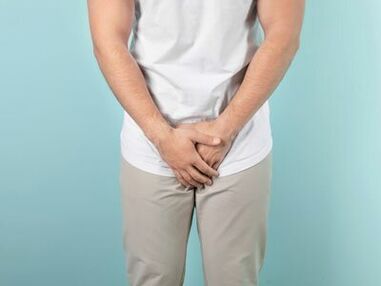
Normally, the male genital organs produce a certain secretion, which mainly performs a protective function. However, a change in the properties and frequency of discharge can be an early sign of the development of a urological disease, for example, a sexually transmitted infection, an inflammatory process or a tumor. Every man should know how to distinguish physiological from pathological secretion. In case of deviations from the norm, you should immediately seek medical help. Below we will consider the most common types of urethral discharge in men and their possible causes.
Genital discharge in men: normal and abnormal
The secretion of the genitourinary organs in men comes out through the urethra or urethra. The following variants of physiological discharge in men are possible:
- Urine.Liquid with yellow tint and weak characteristic smell. Normally released in batches during controlled mixing. One of the urinary disorders is urinary incontinence. In this case, there is either periodic uncontrolled release of urine in parts with different volumes, or constant, but drop by drop. This symptom indicates a pathology of the urinary system.
- Pre-sperm.Colorless and odorless mucus, which is secreted during sexual and erotic stimulation (during masturbation, moderate erotic stimulation, during sexual intercourse and before ejaculation). It is produced by Cooper's glands located preurethral. Pre-ejaculate serves as a natural lubricant and deacidifier in the male urethra and female genital tract to increase sperm viability. A deviation from the norm is the release of pre-ejaculate in a large volume.
- Secretion of the prostate.Gray to white opalescent liquid. Produced by the prostate, it is part of the ejaculate and ensures the normal fertilizing ability of the sperm. The release of prostate fluid outside of ejaculation is called prostatorrhea. Normally, the secretion can be released during mechanical action on the gland (massage) and during straining (during defecation). Other forms of prostatorrhea indicate disturbances in the functioning of the gland.
- They ejaculate.Gray to white mucous fluid with a characteristic odor. It has a complex composition. It is normally released during ejaculation during male orgasm. Physiological is considered to be the release of ejaculate during sexual intercourse and during wet dreams (in adolescents and adult men during abstinence), as well as during strong sexual and erotic stimulation. Isolated cases of ejaculation during sleep, as a result of fear or physical stress, are not considered pathology. All other options for sperm release are a reason to consult a doctor.
Often the attention of men is attracted by the white discharge on the head. This is smegma, or sebaceous gland secretion. Normally, the secretion is evenly distributed on the head, washed off during hygiene procedures and does not cause any discomfort. 
If the glands are overactive or the rules of personal hygiene are violated, the secretion accumulates in the preputial sac (in the foreskin) and becomes clearly visible. Microorganisms can use smegma for their reproduction. Therefore, preventing the stagnation of secretions is an important measure for maintaining the health of the genital organs. If the secretion is produced in excess, you should consult a doctor.
Normal discharge in men should be as described above. Any change in the properties, frequency and time of urine, discharge or secretion of the prostate should alarm you and be a reason to contact a urologist.
Pathological discharge from the urethra in men
Unusual secretion from the urethra indicates the development of a pathological process in the genitourinary tract. Urological diseases in men can manifest not only in heavy flow. Even scanty discharge, which alternates with "clean" periods, should attract attention. The most common types of pathological discharge in men are as follows:
- Slime.Abundant secretion of mucus accompanies inflammatory changes in the urethra. The discharge can be clear, cloudy or white.
- Mucopurulent discharge.The discharge of pus from the urethra indicates an infectious process. A large amount of pathological discharge provokes a feeling of stickiness and discomfort. Scarce - found exclusively in the form of traces in linen.
- White discharge. White mucus discharge in men accompanies infectious and non-specific inflammatory processes. A thick, cheesy discharge usually accompanies candidiasis.
- The gray secret.Liquid discharge or gray mucus can be secretion of sperm or prostate that flows out of physiological conditions. But it is better to consult a specialist to rule out pathology.
- Bloody affairs.Brown or pink urine, bright red or clear mucus stained with blood, as well as the appearance of blood in the semen are signs of structural changes in the genitourinary organs, which may be caused by damage, intense inflammation or the development of a neoplasia.
- Bad download.Discharge with an unpleasant smell is characteristic of genital infections. A specific putrid or rotten smell emanating from the genitals should be a reason to immediately consult a doctor.
Over time, even without treatment, a man may notice a change in the nature and volume of pathological discharge. In some cases, secretion stops, which creates the appearance of recovery. However, this is often associated with the development of a chronic pathological process and its transition to a slow form. After some time, pathological discharge from the urethra in a man may resume. The chronic course of diseases of the urogenital tract is fraught with the development of serious complications (impotence, infertility, etc. ).
What other symptoms can there be?
Diseases of the genitourinary system in men are rarely manifested exclusively as discharge that does not correspond to the norm. Other symptoms also require attention, as they can be used to make assumptions about the localization of the pathological process. A man may be concerned about the following deviations:
- dysuric disorders (frequent urges, difficulty urinating, feeling of incomplete emptying, burning and stinging during urination);
- changes in urine parameters (unusual color, smell, foaming, cracked sediment, etc. );
- pain in the lower abdomen;
- intoxication syndrome (weakness, drowsiness, apathy, etc. );
- decreased sexual desire;
- erectile dysfunction;
- problems with ejaculation (premature ejaculation, difficulty reaching orgasm, changes in sperm properties, etc. );
- aching pain in the lower abdomen, perineum or scrotum, etc.

Pathological discharge can occur in both infectious and non-infectious diseases. The following symptoms will indicate the infectious nature of the deviations:
- pain, burning during urination;
- groin itching;
- rash, sores on the genitals;
- unpleasant odor emanating from the genitals;
- decreased sexual desire;
- pelvic pain;
- increase in body temperature, drowsiness, weakness, etc.
You should seek help immediately after the onset of symptoms. The sooner the diagnosis is made and the appropriate treatment prescribed, the greater the chances of a full recovery.
What should a man do if he has urethral discharge?
A doctor will help you accurately determine the nature of the pathological discharge. If you have signs of diseases of the urogenital tract, you should contact a urologist. The initial reception takes place in the following order:
- Conversation with the patient.The doctor conducts a study, discovers the complaints and collects the anamnesis. Honesty when communicating with a specialist is extremely important for determining further examination tactics.
- Physical examination.The urologist visually assesses the condition of the genital organs and mucous membranes. Digital rectal examination allows you to first determine the size, structure and tenderness of the prostate gland.
- Diagnosis. The urologist takes a smear from the urethra, which is then sent for microscopic analysis. According to the indications, the patient is prescribed additional laboratory methods (blood, urine and PCR tests for sexually transmitted infections) and instrumental methods (ultrasound of the pelvic organs, prostate, etc. ).
Based on the results of the examination, the doctor makes a final diagnosis and prescribes the appropriate treatment.
Treatment of secretions in men
To eliminate the pathological discharge, etiotropic therapy is carried out, which corresponds to the cause of the existing deviations. Treatment may include the following:
- Drug therapy using antibacterial, antiviral, antiprotozoal drugs, as well as immunomodulators and anti-inflammatory drugs.
- Physiotherapy is used in the complex treatment of chronic infectious and inflammatory diseases.
- Surgical methods - structural changes, hyperplastic processes and neoplasms are mainly eliminated using minimally invasive operations.
The most common cause of male discharge is sexually transmitted infections. In this case, conservative treatment is performed. Therapy is performed on an outpatient basis. The duration of treatment varies from several days to several months (depending on the type and form of the disease). At the end of the treatment, a control laboratory examination is performed.
Prevention of discharge in men
Physiological secretion reflects the normal state of health of the male reproductive system. What should be prevented is not discharge, but diseases of the genitourinary tract. To achieve this goal, urologists recommend the following activities:
- compliance with personal hygiene rules;
- wearing underwear made from natural fabrics;
- selectivity in choosing sexual partners;
- use of barrier contraception during casual sexual intercourse;
- avoiding hypothermia;
- regular physical activity;
- Balanced diet;
- rejection of bad habits;
- annual preventive examinations with a urologist.
In conditions of lack of immunity, the sensitivity of the body to representatives of opportunistic microflora increases. Microorganisms that normally do not cause disease can cause the development of a nonspecific infectious-inflammatory process. Therefore, in conditions of increased physical or psycho-emotional stress, acclimatization and treatment with drugs that reduce immunity, it is necessary to carefully observe preventive measures.
















































































